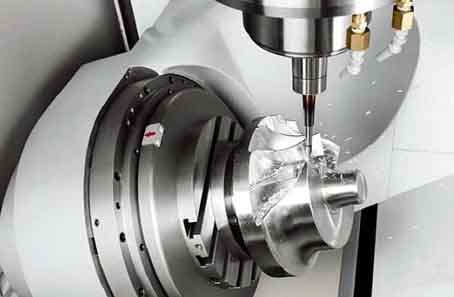Turbine impellers with complex shapes need to be machined with a 5-axis milling machine to be able to machine every corner of its geometry.
In a modern design system, the geometry that needs to be processed is designed by the CAD system, and then converted into the tool trajectory in the CAM system. The output result is converted into the movement of each of the 5 axes of the milling machine through a post-processing program. For turbomachinery impellers, it is necessary to consider dedicated CAM software. In terms of technology, impeller processing is mainly composed of the following 5 distinct operations:
1, the flow path between the rough machining blades
2, milling the hub part
3. Milling round inlet and outlet edges
4. Finishing the surface of the impeller blade with a small amount of cutting
5. Variable radius fillet processing of the root of the impeller blade

5 터빈 임펠러의 축 밀링
Special attention should be paid to areas on the surface of the impeller blades that cannot be reached by the tool. Because at this time it is easy to cause interference between the cutter and the adjacent blades.
5축 CNC 머시닝센터 도입 전, 대부분의 터보 기계 제조업체는 임펠러를 처리하기 위해 3축 또는 4축 공작 기계를 사용했습니다., 그리고 대부분 포인트 가공을 사용했습니다.. 그건, 블레이드 표면의 모든 지점은 도구 팁에 의해 지점으로 처리됩니다.. 도구가 블레이드 표면을 따라 움직일 때, 약간의 구덩이나 날카로운 모서리가 남을 것입니다., 이러한 구덩이 또는 날카로운 모서리의 높이는 프로그래밍 기술에 따라 다릅니다.. 포인트 처리도 가능한 방법입니다, 하지만 이 방법에는 피할 수 없는 단점이 있습니다.:
1. The surface of the impeller blade is not smooth, leaving some small grooves. These small grooves must be parallel to the flow direction (그림 참조 1).
2. For blades with severe curvatures, due to the close spatial distance of the impeller blades, it is difficult to avoid interference with adjacent blades during processing.
3. If you want to reduce the influence of the groove on the flow field, a long processing time is required. 다시 말해서, the tool must move many times around the impeller blades.
 English
English العربية
العربية 中文(漢字)
中文(漢字) Čeština
Čeština Dansk
Dansk Nederlands
Nederlands Suomi
Suomi Français
Français Deutsch
Deutsch Italiano
Italiano 日本語
日本語 ಕನ್ನಡ
ಕನ್ನಡ 한국어
한국어 Português
Português Русский
Русский Slovenčina
Slovenčina Español
Español Svenska
Svenska Türkçe
Türkçe

